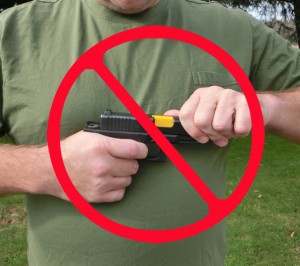“The fast and/or emphatic reholster is an awesome way to shoot yourself.” – Chuck Haggard
We often see people practicing for a faster draw from the holster, and as they speed up each draw they also start SLAMMING the gun quickly back into the holster on every repetition. That’s a very predictable result of getting a little adrenalin going. “Faster! Go faster!” is the chant in your head, after all, so it’s no surprise that your body reacts to it by going faster.
Even when it shouldn’t.
This pattern creates one of the most common ways that people shoot themselves, as we discussed yesterday. Among experienced and otherwise well-trained gun owners, a habit of jamming the gun into the holster very quickly and without thinking accounts for a huge number of close calls. And for far too many serious injuries.
As Karl Rehn, one of the best and most experienced instructors in the business, says: “The two scariest moments I’ve had occur in classes both were [negligent discharges] while re-holstering.” Pull aside any professional trainer who has been in business for a significant time, and you’ll likely hear similar stories.
This is an error that happens to experienced shooters more often than it happens to utter newbies. And it happens because we naturally pay more attention to the draw than we do to the reholstering procedure.
What to do instead
Here’s the key point:
Practice putting the gun away slowly, smoothly, and with full awareness every time you have drawn the gun.
Slowly. Smoothly. With full awareness.
Do this even when you are drawing and shooting as fast as you can go. Do this even when “only” practicing in dry fire at home. Do this even when your buddies roll their eyes at your caution.
And especially, do this when you are just putting the gun in the holster as the normal start to your day. Build a habit of putting the gun away slowly, smoothly, and with full awareness no matter what else you have been doing and no matter what you are intending to do next.
That’s the key.
“Full awareness” means that we think about what we are doing when we reholster — not about the target, not about the timer, not about the person next to us or behind us.
It means we pay attention …
- to the trigger finger: is it off the trigger, outside the trigger guard, and away from the side of the gun?
- to the non-shooting hand: is it anchored in a spot well away from the holster and well away from the muzzle of the gun?
- to the clothing: is everything away from the mouth of the holster so there’s room for the gun to enter?
- to the signals we get from our bodies: does everything look and feel ‘right’?
Put the gun into the holster slowly, smoothly, and with full awareness. Every time.
Why is this necessary?
This slow, smooth, full-awareness thing is needed because stopping a preplanned action (such as the motion of putting the gun into the holster) takes time, especially when unexpected new information comes in. Whenever we holster, we want to be sure we have enough time to stop if we need it. And we want to be sure we are paying attention to the signals that might tell us we need to stop.
Here is an excerpt from Motor Control and Learning, by human performance researchers Richard A. Schmidt and Timothy D. Lee:
“Apparently, once the [person] has committed to action, the movement occurs even when some signal is presented in the environment indicating that the action should not be performed. As mentioned in chapter 4, inhibiting preplanned actions requires time and attention…”
The book goes on to explain the factors that can increase or decrease the amount of time it takes a person to process the new information and either change or stop their movement altogether. One key factor: how familiar the motion already is. So if it’s something we’ve practiced doing a lot, it will be harder for us to stop in the middle of that motion than it would be if it were something we were just learning how to do.
That’s one of the reasons people who are very familiar with holster use are not immune to this type of injury. And it’s why experienced shooters should reholster just as slowly and with just as much awareness as they did when they were beginners.
What unexpected information?
The type of unexpected information we might get when holstering could include the body’s feedback system telling us:
- “Hey! Your finger is still on the trigger!”
- “Uh, there’s something blocking your holster.”
- “Your drawstring just entered the trigger guard… That’s not good.”
… or any number of other things.
We weren’t expecting something to be not-right, so this message is (in human reaction jargon) an “unexpected stimulus.” And it takes time for our brains to process that unexpected information and react by telling the body to stop the motion.
In every case, when this dangerous, unexpected information presents itself, a smart person who does not want an extra hole in their leg will STOP putting the gun into the holster. But it takes a little time for the unexpected signal from the nerves to get up to the brain, and a little more time for the brain to decide what to do about it (oh, yeah, we should STOP moving now), and then still more time for the STOP signal to get back down to the hand that’s already moving.
We won’t have the time we must have in order to STOP before a loud noise happens, if we are slamming the gun into the holster instead of easing it in gently.
A Key Point
Have you ever gone to throw a set of keys to a friend, then noticed they weren’t looking, tried to stop yourself … and then thrown the keys anyway, even though you tried to stop that motion?
Same thing. Your body was moving faster than your brain could stop the motion after you got the information that your friend wasn’t ready for you to throw the keys.
But the consequence of moving faster than you can stop a trigger press is much more serious than a set of thrown keys.
How slowly is “slowly”?
By now, you’re probably wondering how slow is slow enough. Are we talking about the speed of a three-toed sloth, or just a slow loris type speed?

Are we talking about the speed of a three-toed sloth, or just a slow loris type speed? (Photo by David Haring / Duke Lemur Center)
Generally (very generally!) speaking, the human reaction time to a known and expected stimulus begins at around a quarter of a second (0.25 seconds) for most people. That’s the moment when we first begin to respond to a stimulus. However, this number varies from one person to another. And it changes based on a whole bunch of other factors, too, especially including how we measure it.[ref]Human reaction time is a complex subject with a bajillion little variables to define and track. Because it is complex, a short summary such as I’ve provided here cannot do it justice — but hopefully as a practical field guide, this short explanation may be enough to explain why we should holster more slowly than we generally do. See [this link] for an easy to read overview of other things you might want to know about human reaction times.[/ref]
Now for the tricky part: we are not talking about an expected stimulus, but about a stimulus that we don’t expect. That it’s unexpected and also probably an unfamiliar feeling could add at least another half to three-quarters of a second, and often more — up to around 1.5 seconds, according to most of the literature on this subject.
We can probably cut the time back down a little bit by cultivating the mental habit of expecting to feel resistance or expecting a need to stop moving every time we put the gun into the holster. But human nature being what it is, that’s a mental trick with a limited shelf life. Most of us will lapse back into expecting what happens most often — no STOP signal from the nerves to the brain, and a completion of the holstering movement. So I wouldn’t put a lot of eggs in that particular basket.
So… how slow is slow enough? I’d suggest that from the moment the muzzle of the gun nears the mouth of the holster, to the moment the gun is fully seated and secure inside the holster, should take around one second or a little more.
Please notice that I am only talking about the final moments of the holstering process — from muzzle touch to being fully seated. You can bring the gun back to your ready position as quickly as you like, and even move quickly toward the holster if you need to. But that last little bit, as the gun actually enters the holster and gets put solidly into its place, that is the part that needs to take at least a second of your time and all your attention.
One second. From holster mouth to fully seated.
That sounds fast — it’s just a second, after all! But compared to what most people do most of the time, it’s glacially slow.
Try it and see.
What to do about all this?
Simply this: Put the gun away slowly, smoothly, and with full awareness … EVERY TIME.
Take your time. Every time.
Be present in the moment. Every time.
Every time you holster, make sure your finger is out of the trigger guard and away from the side of the gun. Every time, make sure your non-shooting hand is well away from the holster and anchored in a safe spot. Every time, make sure your clothes are away from the mouth of the holster. And every time, ease the gun gently into the holster while giving your full attention to what you are doing.
Take a second.
Commit yourself to practice a carefully aware reholster with every bit as much diligence as you practice your smooth and efficient draw.
Stay safe.
 Yet “feeling safe” isn’t a right that belongs only to non-gun owners. If a particular feeling can be a “right” at all (a questionable premise, but let’s run with it) — and it’s a right that belongs to any of us, it would be a right that belongs to all of us.
Yet “feeling safe” isn’t a right that belongs only to non-gun owners. If a particular feeling can be a “right” at all (a questionable premise, but let’s run with it) — and it’s a right that belongs to any of us, it would be a right that belongs to all of us.






